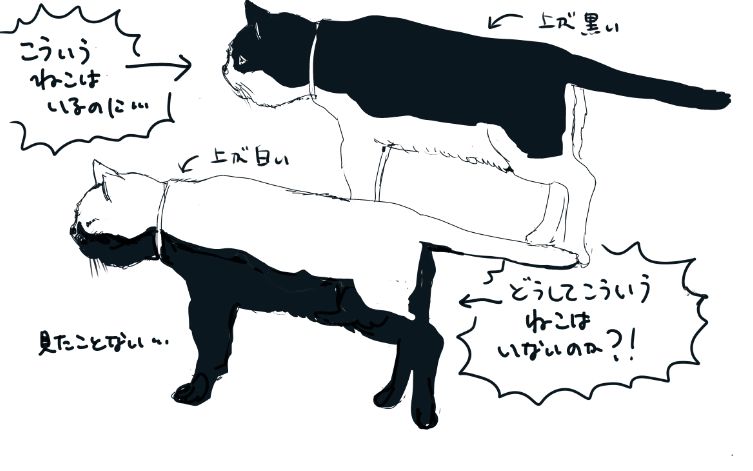
Japanese Twitter alights over one of the great mysteries of the cat world.
For all the time we’ve spent watching cat-related videos on the internet and idly scrolling through cute pictures of kittens on our phones, there was one thought that never crossed our minds: why don’t black-and white cats have pale backs and dark bellies? This is exactly the question that one Twitter user thought to ask last week, and the answers that are coming to light are almost as puzzling as the question posed.
▼ Ami Sugimoto was so intrigued by the
elusive colour combination that she drew an anime-style sketch to
illustrate her point. The black-and-white cat on the right is often
seen, but why not a cat-like the one on the left?

With thousands of retweets, fellow Twitter users have been scratching
their heads over the concept. One person, however, presented an
interesting theory as to the reason why this occurs. According to @Valquasard,
we have to go right to the very early stages of embryonic development
to understand the entire process. While animals all carry a specific
combination of genes which influence the colouring and patterns they
will be born with, cells play a large part in producing those colours
and patterns.
With white being the natural, unpigmented shade, as the embryo develops, the cells responsible for pigmentation move downwards from the vicinity of the spinal area. As these pigmentation cells migrate they encounter inhibitors, causing T-wave patterns that may form speckles or stripes. For solid colours, the cells responsible for pigmentation will migrate from the back and all the way to the front of the animal. In the case of two-tone piebald cats however, these cells stop before the journey is complete, creating the black-back-white-belly combination we see today.

▼ Sometimes the pigmentation cells move
randomly, which explains the reason for the adorable love-heart shape on
the chest of current Instagram star Zoe the cat
Musing on the wonders of the world and nature’s ability to form seemingly random patterns and markings, @Valquasard then dived deeper, bringing up the mystery of Fibonacci number patterns which occur frequently in nature; a system of numbering that can be reflected in the growth and development of a wide variety of living things like leaf and petal arrangements in plants.
Each number in the sequence, which begins with 1, 1, 2, 3, 5, 8, 13, comes from adding the two numbers before it, and is considered to be one of the principal laws of nature. The number of petals on many flowers, for instance, is a Fibonacci number: lilies have three petals, buttercups have five petals and daisies can have 34, 55 or 89 petals. These numbers are also connected to the creation of patterns in butterfly wings, zebra stripes and nautilus shells, suggesting that the series can be related to the growth of every living thing, including cells that create patterns on piebald cats.
▼ If you count the spirals of the seeds in a sunflower in a consistent manner, you will always find a Fibonacci number.

As for the black-and-white cat mystery, Ami Sugimoto, who initially brought the topic to everyone’s attention, was thrilled to receive a plausible explanation to her query, impressed with the ideas put forward by @Valquasard and thanking him for his input. His suggestions are actually in line with pigment cell development theories presented in a number of research papers like this study, which examines the formation of patterns and colours on mice and zebrafish.

As for the reason why pigmentation cells fail to complete their journey of migration to the stomachs of black and white cats, a paper published earlier this year by researchers at the Univeristies of Bath and Edinburgh suggests a faulty gene reduces cell multiplication rates, meaning there aren’t enough pigment cells to cover the entire skin, leaving the animal with a white belly.

This finding may prove useful in studying why cells fail to move to their correct positions during early stages of development, opening up a range of possibilities for further investigation into embryonic diseases. All thanks to the humble piebald cat.
Sources: Togech, Featherland Cattery, BBC World Service Trust, National Center for Biotechnology Information, U.S. National Library of Medicine
Top Image: Twitter/@SugimotoAmiInfo (edited by RocketNews24)
Insert Images: Pixabay (1, 2, 3, 4)
source

No comments:
Post a Comment